1.TENSORS
1.1 什么是tensors(张量)
在 PyTorch 中,使用tensors来编码模型的输入和输出,以及模型的参数。tensors相当于是numpy.array(),可以在GPU或者其它硬件上用。
1.2 Tensor初始化
1. torch.tensor
torch.tensor(data, *, dtype=None, device=None, requires_grad=False, pin_memory=False)
将data转换为Tensor。data可以是list, tuple, NumPy ndarray, scalar等呈现数组形式的数据。
import torch
# list类型
data = [[1, 2], [3, 4]]
x_data = torch.tensor(data)
print(x_data)
# np.array类型
score = np.array([[0,1],[2,3]])
y_data = torch.tensor(data)
print(y_data)

2. from_numpy(ndarray)
torch.from_numpy(ndarray)将一个numpy.ndarray转换为Tensor,但是要注意这个转换是浅拷贝。(深拷贝用tensor.copy_())
score = np.array([[0,1],[2,3]])
x_np = torch.from_numpy(score) # 浅拷贝score对象
print(f"改变前\nx_np:{x_np},\nscore:{score} ")
# 改变后
score[0][0] = 9
x_np[0][1] = 8
print(f"**********\n改变后\nx_np:{x_np},\nscore:{score} ")
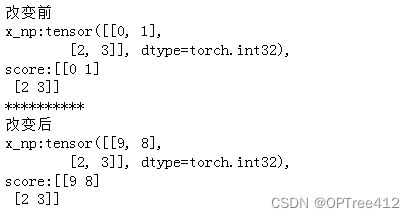
3. torch.ones()、torch.rand()与torch.zeros()
torch.zeros(*size, *, out=None, dtype=None, layout=torch.strided, device=None, requires_grad=False)构建一个所有元素都是0的张量。
torch.ones()、torch.rand()与torch.zeros()同理,但所有元素不同。
rand = torch.rand((3,4))
zero = torch.zeros((3,4))
ones = torch.ones((3,4))

4. torch.ones_like()与torch.rand_like()
torch.ones_like()与torch.rand_like()新张量保留参数张量的属性(形状、数据类型)
x_ones = torch.ones_like(x_data) # 保留 x_data 的属性
print(f"Ones Tensor: \n {x_ones} \n {x_data} \n")
x_rand = torch.rand_like(x_data, dtype=torch.float)
print(f"Random Tensor: \n {x_rand} \n{x_data} \n")
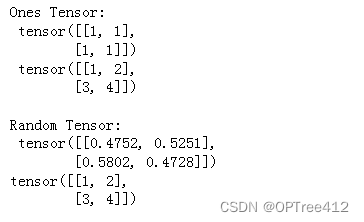
5. arange()
arange(start=0, end, step=1, *, out=None, dtype=None, layout=torch.strided, device=None, requires_grad=False)
rr = torch.arange(6,13)
rrr = torch.arange(13)
rrrr = torch.arange(6, 13, 0.5)
rr,rrr,rrrr

1.3 Tensor 属性
tensor = torch.rand(3, 4)
print(f"Shape of tensor: {tensor.shape}")
print(f"Datatype of tensor: {tensor.dtype}")
print(f"Device tensor is stored on: {tensor.device}")

2. Tensor 使用方式
1. Tensor使用GPUtensor.to('cuda')
if torch.cuda.is_available():
tensor = tensor.to('cuda')
print(f"Device tensor is stored on: {tensor.device}")

2. 更改元素
tensor = torch.ones(4, 4)
tensor[:,1] = 0
print(tensor)
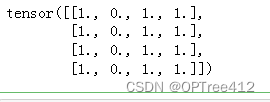
3. 拼接 torch.cat()
torch.cat(tensors, dim=0, *, out=None)串接tensors(一堆非空Tensor进行拼接,在非dim维度必须形状相同),返回结果。
注意:拼接是特定的某个维度进行拼接,其他维度都不管
tensor = torch.ones(4, 4)
tensor[:,0] = 0
t1 = torch.cat([tensor, tensor, tensor], dim=1)
print(t1)

4. Tensors 乘法
对元素层面的乘法Tensor1.mul(Tensors2)或*,矩阵乘法Tensor1.matmul(Tensors2) 或@
temp = torch.ones(4,4)
print(f"\ntemp.mul(nn) {temp.mul(temp)} \n")
print(f"temp * temp \n {temp * temp}")
print(f"temp @ temp \n {temp @ temp}")
print(f"temp.matmul(temp) \n {temp.matmul(temp)}")
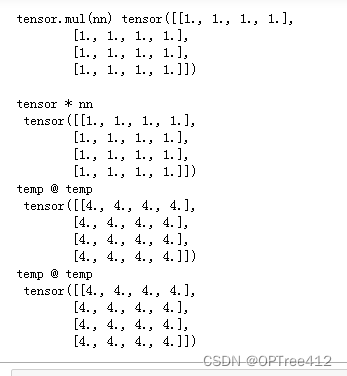
5. Tensors 加法add_(n)
所有元素加n
print(tensor, "\n")
tensor.add_(5)
print(tensor)
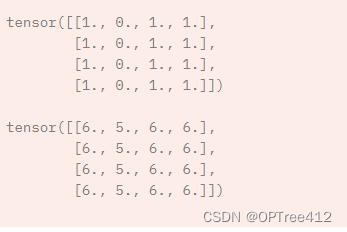
6. 塑形reshape(input, (row,colmn))
把input矩阵改变成row行,colmn列
a = torch.arange(4.).reshape((2, 2))
b = torch.tensor([[0, 1], [2, 3]]).reshape((-1,))
''' 或者
a = torch.arange(4.).reshape((2, 2))
a = torch.reshape(a, (2, 2))
b = torch.tensor([[0, 1], [2, 3]]).reshape((-1,))
a = torch.reshape(b, (-1, ))
'''
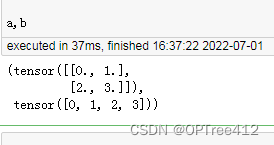
7. 张量收缩squeeze()
squeeze(Tensor, dim=None, *, out=None)去掉Tensor中维度为1的维度,并返回这个Tensor。如果有dim就只对指定维度进行squeeze操作。是深拷贝。
x = torch.zeros(2, 1, 2, 1, 2)
print(x.size())
y = torch.squeeze(x,dim = 1)
print(y.size())
print(x.size())

8. 张量扩张unsqueeze(input, dim)
unsqueeze(input, dim)在input指定维度插入一个长度为1的维度,返回Tensor
9. 维度交换transpose()
transpose(input, dim0, dim1)返回input转置的Tensor,dim0和dim1交换。
x = torch.tensor([1, 2, 3, 4])
print(x.shape)
print(torch.unsqueeze(x, 0))
print(torch.unsqueeze(x, 0).shape)
print(torch.unsqueeze(x, 1))
print(torch.unsqueeze(x, 1).shape)
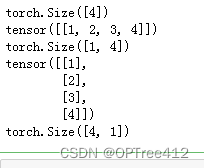
10. 找非零元素nonzero()
nonzero(input, *, out=None, as_tuple=False)
①as_tuple=False:返回一个二维Tensor,每一行是一个input非零元素的索引
torch.nonzero(torch.tensor([[0.6, 0.0, 0.0, 0.0],
[0.0, 0.4, 0.0, 0.0],
[0.0, 0.0, 1.2, 0.0],
[0.0, 0.0, 0.0,-0.4]]))
tensor([[ 0, 0],
[ 1, 1],
[ 2, 2],
[ 3, 3]])
②as_tuple=True:返回一个由一维索引Tensor组成的tuple(每个元素是一个维度上的索引)
注意:where(condition) 和 torch.nonzero(condition, as_tuple=True) 相同
torch.nonzero(torch.tensor([[0.6, 0.0, 0.0, 0.0],
[0.0, 0.4, 0.0, 0.0],
[0.0, 0.0, 1.2, 0.0],
[0.0, 0.0, 0.0,-0.4]]), as_tuple=True)
(tensor([0, 1, 2, 3]), tensor([0, 1, 2, 3]))
11. 求和,平均数,平方
y=x.sum(),y=x.mean(),y=x.pow(2)
2.Autograd(这部分有点乱)
2.1 各个部分
torch.autograd是PyTorch提供的自动求导包,非常好用,可以不用自己算神经网络偏导了。
从概念上讲,autograd 在由 Function 对象组成的有向无环图 (DAG) 中记录数据(张量)和所有执行的操作(以及生成的新张量)。在这个 DAG 中,叶子是输入张量,根是输出张量。通过从根到叶跟踪此图,您可以使用链式法则自动计算梯度。
在前向传递中,autograd 同时做两件事:
运行请求的操作以计算结果张量,并在 DAG 中维护操作的梯度函数。
当在 DAG 根上调用 .backward() 时,反向传递开始。 autograd 然后:计算每个 .grad_fn 的梯度,将它们累积到相应张量的 .grad 属性中,并使用链式法则,一直传播到叶张量。下面是我们示例中 DAG 的可视化表示。在图中,箭头指向前向传播的方向。节点代表前向传递中每个操作的后向函数。蓝色的叶子节点代表我们的叶子张量 。
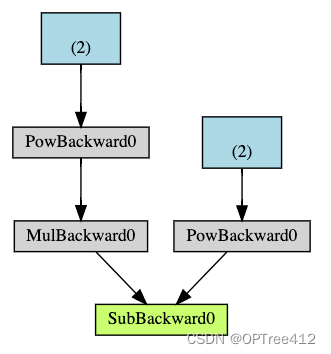
2.2 一轮训练
例1:
- 前向传播:
prediction = model(data) - 反向传播:
1.计算loss
2loss.backward()(autograd会在这一步计算参数的梯度,存在相应参数Tensor的grad属性中)
3.更新参数
1.加载optimizer(通过torch.optim)
2.optimizer.step()对参数使用梯度下降的方法进行更新(梯度来源自参数的grad属性)
import torch, torchvision
# 构建模型、参数、标签
model = torchvision.models.resnet18(pretrained=True) # 模型 将Tensor的requires_grad属性设置为True,可以追踪autograd在其上每一步的操作
# 冻结模型中的所有参数
for param in model.parameters():
param.requires_grad = False
data = torch.rand(1, 3, 64, 64) # 数据 创建一个随机数据张量来表示具有 3 个通道、高度和宽度为 64 的单个图像
labels = torch.rand(1, 1000) # 将其对应的标签初始化为一些随机值。 预训练模型中的标签具有形状 (1,1000)。
# 前向传播
prediction = model(data) # 获取模型预测结果
loss = (prediction - labels).sum() # 计算损失函数
# 反向传播
loss.backward() # 计算参数的梯度 .grad()中存储梯度
optim = torch.optim.SGD(model.parameters(), lr=1e-2, momentum=0.9) # 随机梯度下降 学习率0.001
#最后,调用 .step() 来启动梯度下降。 优化器通过存储在 .grad 中的梯度来调整每个参数。
optim.step() #gradient descent
例2:
import torch
# 追踪运算在其上每一步的操作
a = torch.tensor([2., 3.], requires_grad=True)
b = torch.tensor([6., 4.], requires_grad=True)
Q = 3*a**3 - b**2 #把Q当做损失函数,a,b当做参数
# 计算梯度
# 对Q计算梯度时,需要在backward()函数中添加gradient参数,这个gradient是和当前Tensor形状相同的Tensor,包含当前Tensor的梯度
external_grad = torch.tensor([1., 1.])
Q.backward(gradient=external_grad)
print(9*a**2 == a.grad) #tensor([True, True])
print(-2*b == b.grad) #tensor([True, True])
参考: